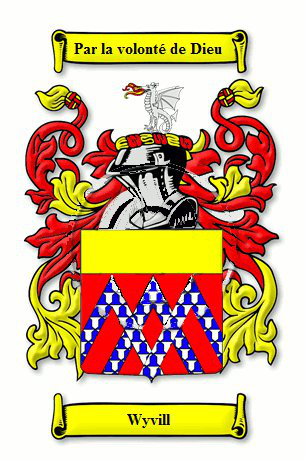Percival Wyvill 1885-1947
 Born in Croydon on the 26th September 1885. He enlisted in the Royal Marines under the name of Percy Wyvill,
on the 6th March 1903 giving his date of birth as 22nd July 1885 to obviate the possibility of being "reclaimed"
by the family.
He served continuously until 14th August 1922. This period covered the 1914 - 1918 war during which he served on HMS Lord Nelson in 1915 in the Dardanelles campaign. He maintained a separate diary in 1915 which is with the family files.
Born in Croydon on the 26th September 1885. He enlisted in the Royal Marines under the name of Percy Wyvill,
on the 6th March 1903 giving his date of birth as 22nd July 1885 to obviate the possibility of being "reclaimed"
by the family.
He served continuously until 14th August 1922. This period covered the 1914 - 1918 war during which he served on HMS Lord Nelson in 1915 in the Dardanelles campaign. He maintained a separate diary in 1915 which is with the family files.
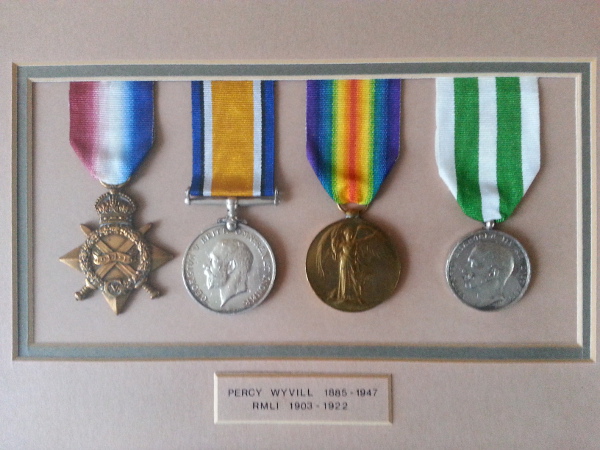
On December 28th 1908 there was an earthquake at the Straits of Messina which affected both Scicily and Mainland Italy at Reggio and resulted in a death roll of some 140,000 people. At that time Percy was serving on HMS Duncan at Malta. HMS Duncan and four other Royal Navy ships sailed immediately to Messina and did invaluable rescue and relief work. Percy was awarded the Italian Commerative Medal for his part in the work.
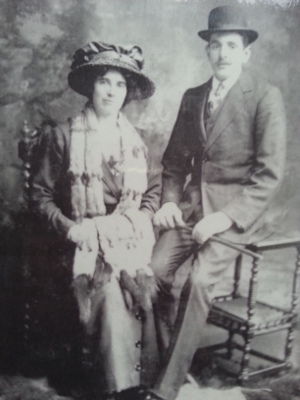
Percival married Florence Mary Jennings at St. Luke's church, Hornsey, London on 28th December 1912. see family tree for pictures
Percival and Florence had three children, all born in Hornsey: Percival Leslie Wyvill 1918 - 1969, Kenneth Wyvill 1921 - 2001, and Doreen Leonora Wyvill b.1926.
On 11th November 1920 he was one of the Royal Marine Guard when the "Unknown Warrior" was first laid to rest in Westminster Abbey, London. On leaving the Marines he joined the "General Post Office" as a telephone Engineer. He was involved in communications during the second world war 1939 - 1945. He also served in the Home Guard during this time. Percival died at home in Hornsey 16th April 1947.
HMS DUNCAN (1903). "Duncan" class First class Battleship
 Displacement : 13,640tons / 15,100 tons full load. Dimensions : length 405ft. (p.p) 432ft. (o.a), beam 75ft. 6in., draught 25ft. 9in.Armament : 4 x 12in. BL (4x2), 12 x 6in. QF (12x1), 10 x 12pdr. QF (12x1).,6 x 3pdr.QF (6x1)., 2 x Maxims guns. Torpedo tubes 4 x 18in. (submerged)., torpedoes carried 18 x 18in, 6 x 14 in. Armour : Belt 7in., bulkheads 7in - 11in., barbettes 4in - 11in., shields 8in - 10in., ammunition tubes 2in., conning towers 3in - 12in., casements 2in - 6in., decks, lower 1in - 2in.,
middle 1in., main 1in. - 2in.Machinery : 2-shafts, 2 x 4 cylinder inverted triple expansion, 24
Belleville boilers, with economizers; 300lb. pressure. cylinders 2 x33.5in., 2 x 54.5in., 4 x 63in., 4ft. stroke, Revs. 120.
Horse power 18,000= 19 knots.Fuel : coal 900tons - 2,240tons.Complement : 720Silhouette : 2 funnels 2 masts. Builder :
Thames Iron Works, laid down July 1899, launched March 1901,completed October 1913. Cost £1,093,000 (ave. for six).Commission : Chatham 1903 for Mediterranean, seved there until January 1905,then transferred to Channel Fleet. Rammed ALBION at Lerwick sept. 26th.1905, 22 days for repairs. Grounded on Lundy Island July 1906, while trying
to assist stranded MONTAGU, 72 days for repairs. Atlantic Fleet 1907; refitGibraltar November 1907 - February 1908. Transferred to MediterraneanNovember 1908. Refit Malta 1909, rear - Admiral Flagship MediterraneanAugust 1910 - June 1912. Returned home June 1912 and joined 4th. BattleSquadron 1st. Fleet until May 1913 when she became 2nd. Fleet gunnery tenderat Portsmouth. World War One : August 1914, 6th. Battle Squadron 2nd. Fleeton Northern patrol. November joined "King Edwards" in the 3rd. BattleSquadron and moved to Portland and later to Dover. Mediterranean Fleet 1915, took little part in Dardanelles operations. 1917 moved back to UK, went intoReserve, to release men for other duties. Sold 1920.
source info
British Battleships (1860 - 1950) by Dr. Oscar Parkes O.B.E., A.I.N.A.,
(1957)., Seeley Service & Co. London. 196 Shaftsbury Avenue,WC., ISBN 0
Displacement : 13,640tons / 15,100 tons full load. Dimensions : length 405ft. (p.p) 432ft. (o.a), beam 75ft. 6in., draught 25ft. 9in.Armament : 4 x 12in. BL (4x2), 12 x 6in. QF (12x1), 10 x 12pdr. QF (12x1).,6 x 3pdr.QF (6x1)., 2 x Maxims guns. Torpedo tubes 4 x 18in. (submerged)., torpedoes carried 18 x 18in, 6 x 14 in. Armour : Belt 7in., bulkheads 7in - 11in., barbettes 4in - 11in., shields 8in - 10in., ammunition tubes 2in., conning towers 3in - 12in., casements 2in - 6in., decks, lower 1in - 2in.,
middle 1in., main 1in. - 2in.Machinery : 2-shafts, 2 x 4 cylinder inverted triple expansion, 24
Belleville boilers, with economizers; 300lb. pressure. cylinders 2 x33.5in., 2 x 54.5in., 4 x 63in., 4ft. stroke, Revs. 120.
Horse power 18,000= 19 knots.Fuel : coal 900tons - 2,240tons.Complement : 720Silhouette : 2 funnels 2 masts. Builder :
Thames Iron Works, laid down July 1899, launched March 1901,completed October 1913. Cost £1,093,000 (ave. for six).Commission : Chatham 1903 for Mediterranean, seved there until January 1905,then transferred to Channel Fleet. Rammed ALBION at Lerwick sept. 26th.1905, 22 days for repairs. Grounded on Lundy Island July 1906, while trying
to assist stranded MONTAGU, 72 days for repairs. Atlantic Fleet 1907; refitGibraltar November 1907 - February 1908. Transferred to MediterraneanNovember 1908. Refit Malta 1909, rear - Admiral Flagship MediterraneanAugust 1910 - June 1912. Returned home June 1912 and joined 4th. BattleSquadron 1st. Fleet until May 1913 when she became 2nd. Fleet gunnery tenderat Portsmouth. World War One : August 1914, 6th. Battle Squadron 2nd. Fleeton Northern patrol. November joined "King Edwards" in the 3rd. BattleSquadron and moved to Portland and later to Dover. Mediterranean Fleet 1915, took little part in Dardanelles operations. 1917 moved back to UK, went intoReserve, to release men for other duties. Sold 1920.
source info
British Battleships (1860 - 1950) by Dr. Oscar Parkes O.B.E., A.I.N.A.,
(1957)., Seeley Service & Co. London. 196 Shaftsbury Avenue,WC., ISBN 0
Messina-Reggio Earthquake 1908
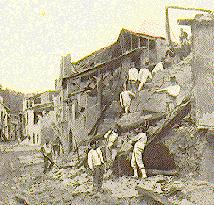 Messina - Reggio earthquake of 1908 is well documented from a family point of view.
On the left is a picture of the relief workers. (courtesy of Frank Arduini)
Messina - Reggio earthquake of 1908 is well documented from a family point of view.
On the left is a picture of the relief workers. (courtesy of Frank Arduini)
On December 28, 1908 at 5:21 am an earthquake hit Messina, a town in Sicily, Italy as well as Reggio Calabria located on the mainland. The earthquake's magnitude was a 7.35 according to today's Richter scale. It lasted approximately 30 to 40 seconds and the destruction was felt within a 300 km radius. Moments after the earthquake hit a tsunami struck many of the coastal cities with forty foot waves causing even more destruction.
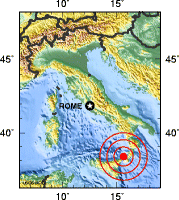
This would be the fourth largest tsunami that ever occurred. Coming with no warning, and killing over 100,000 people in Messina alone, this earthquake and tsunami left the town completely destroyed, with 91% of its buildings down and weeks of searching for missing people. Considering the population of Messina was only 150,000 the death toll was devastating. This would be the strongest earthquake to ever hit Messina, and Europe for that matter. Records show families trapped under the rubble of buildings for days before they were found, remarkably alive. The reason that so many buildings collapsed was, in part, poor and unstable construction practices at that time. The buildings at that time were massive with heavy roofs and floors that could not withstand the shaking and rumbling of the ground.
The disaster made it to the headlines of the newspapers and initiated world-wide relief efforts. With the help of the Red Cross, British sailors, and even the King and Queen of Italy, the search and cleanup was expedited. Treatment centers were located north of Sicily in Naples.
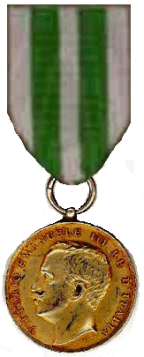
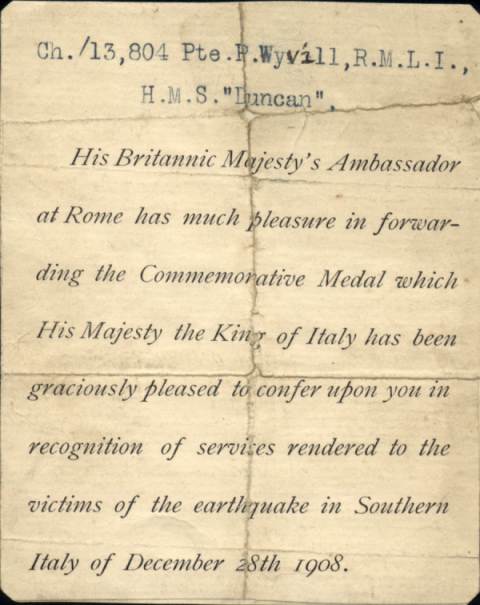 This is the Royal Italian Navy medal (actual size 1.25" left) awarded to Pte. P. Wyvill for his participation in the relief effort following the 1908 quake. On the front is a profile of the Italian king with the inscription:
This is the Royal Italian Navy medal (actual size 1.25" left) awarded to Pte. P. Wyvill for his participation in the relief effort following the 1908 quake. On the front is a profile of the Italian king with the inscription:
VITTORIO EMANUELE III RE D'ITALIA
Above is a graphic of the original document that accompanied the medal as presented by his Britannic Majesty's Ambassador to Italy.
COVERED WITH THE HISTORIC"PADRE'S FLAG", AND THE PALL, AND GUARDED BY MEN OF THE FOUR SERVICES: THE GRAVE AFTER THE ABBEY CEREMONY.
Burial Date: 11 Nov, 1920
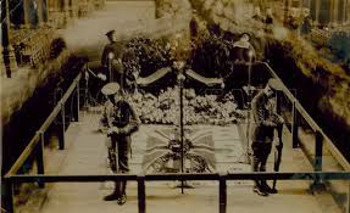
After the Abbey service the grave was enclosed, and within the barrier were posted four sentrys: The Army (left foreground) ;the Air Force (right foreground); the Marines (left background Percival Wyvill) ;and the Navy (right background). The grave was covered with the abbey pall and over it was thehistoric flag known as the "Pardre's Flag"presented by the Rev. David Railton M.C., Vicar of Margate, who first suggested to the Dean of Westminster the idea of burying an Unknown Warrior in the Abbey.
The flag was given to Mr. Railton when he went to France as an army chaplain, and it was used, for purposes many and various, on many famous battlefields. He brought it back stained with British blood, and it will now hang in Westminster Abbey. Upon it are three wreaths, including the King's, and others are laid at the end of the grave ---(photograph by L.N.A.)

BENEATH THIS STONE RESTS THE BODY OF A BRITISH WARRIOR UNKNOWN BY NAME OR RANK BROUGHT FROM FRANCE TO LIE AMONG THE MOST ILLUSTRIOUS OF THE LAND AND BURIED HERE ON ARMISTICE DAY 11 NOV: 1920, IN THE PRESENCE OF HIS MAJESTY KING GEORGE V HIS MINISTERS OF STATE THE CHIEFS OF HIS FORCES AND A VAST CONCOURSE OF THE NATION THUS ARE COMMEMORATED THE MANY MULTITUDES WHO DURING THE GREAT WAR OF 1914-1918 GAVE THE MOST THAT MAN CAN GIVE LIFE ITSELF FOR GOD FOR KING AND COUNTRY FOR LOVED ONES HOME AND EMPIRE FOR THE SACRED CAUSE OF JUSTICE AND THE FREEDOM OF THE WORLD THEY BURIED HIM AMONG THE KINGS BECAUSE HE HAD DONE GOOD TOWARD GOD AND TOWARD HIS HOUSE
